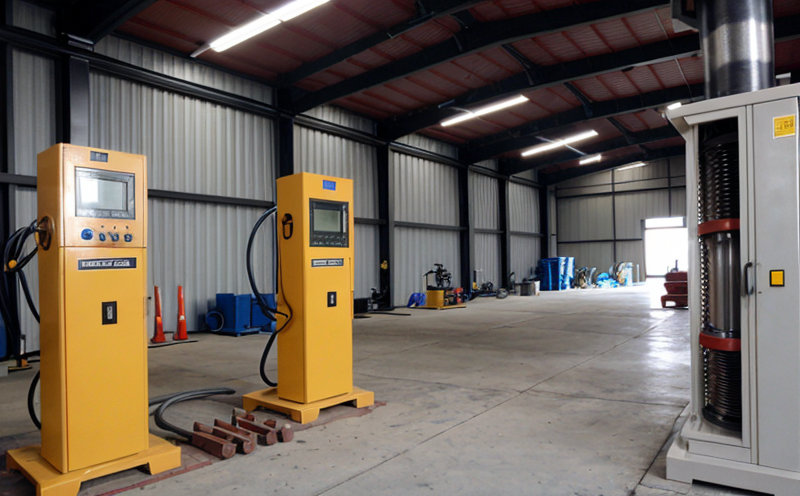ASTM D7386-14 Load Bearing Under Long-Term Pressure
The ASTM D7386-14 standard outlines a method to evaluate the load-bearing capacity of packaging materials under long-term pressure. This test is crucial in ensuring that packaging designed to withstand significant mechanical stress over extended periods performs reliably without failure.
The ASTM D7386-14 test is particularly relevant for products like pharmaceuticals, electronics, and food items that are packaged in containers intended for storage or shipment under conditions of high pressure. The standard specifies the procedures for determining the long-term load-bearing capacity of packaging materials by applying a constant load over an extended period.
The testing setup involves placing a specimen between two rigid plates with a specified area contact. The load is applied gradually and held at that level for a defined duration to simulate real-world conditions where containers may experience prolonged periods of pressure due to stacking or storage in warehouses.
Specimen preparation is critical; the materials used must be representative of those intended for commercial use. This includes ensuring that any adhesives, coatings, or other additives are consistent with industry standards and do not adversely affect test results. The specimens should also be conditioned under controlled environmental conditions to ensure they are at equilibrium before testing.
The mechanical strength of packaging materials is tested using a compression testing machine capable of applying the specified load accurately over time. The duration of the test can vary depending on the material properties and desired outcome, but it typically ranges from several days to weeks or even months in some cases.
Testing results are analyzed based on the amount of deflection observed under the applied load. Deflection is measured using precise instruments that record displacement at regular intervals throughout the testing period. Compliance with the standard requires that the material does not fail within the specified time frame and meets the required performance criteria in terms of structural integrity.
This test ensures that packaging designed for long-term storage or transport under pressure will perform reliably, protecting the contents from damage during transit or storage. By adhering to ASTM D7386-14, manufacturers can demonstrate compliance with regulatory requirements and enhance customer satisfaction by delivering products in undamaged packaging.
Understanding how different materials behave under long-term load conditions is essential for designing more robust and efficient packaging solutions. This test helps identify potential weaknesses early in the development process, allowing for necessary adjustments to improve performance before product release.
Benefits
- Enhanced Reliability: Ensures that packaging materials can withstand prolonged periods of mechanical stress without failure.
- Improved Product Protection: Protects contents from damage during transport or storage, ensuring product integrity and quality.
- Compliance Assurance: Helps manufacturers meet regulatory requirements for long-term load-bearing capacity in packaging.
- Informed Decision-Making: Provides valuable insights into the performance characteristics of different materials, aiding in material selection and design optimization.
- Cost Savings: Identifies potential issues early, reducing the risk of costly recalls or product damage during shipment.
The ASTM D7386-14 test is a vital tool for ensuring that packaging meets rigorous standards for long-term load-bearing capacity. By conducting this test, manufacturers can gain confidence in their products' ability to perform reliably under demanding conditions.
International Acceptance and Recognition
- ISO/IEC: The ASTM D7386-14 standard is recognized globally for its robust methodology, ensuring consistent testing results across different regions.
- Australian Standards (AS): Australia's equivalent standard may align with or reference the ASTM D7386-14 guidelines to ensure compatibility and consistency in packaging performance evaluation.
- European Standards (EN): European countries often adopt ASTM standards through their national standards bodies, integrating them into local regulations for product safety and quality assurance.
- New Zealand Standards (NZS): New Zealand may follow the ASTM D7386-14 standard or develop its own variant that closely aligns with it to ensure consistent testing procedures across the region.
- Canadian Standards: Canadian standards for packaging often incorporate ASTM guidelines, ensuring compliance and reliability in cross-border trade.
- Other Regions: Many other regions worldwide rely on or reference ASTM D7386-14 to ensure that packaging materials meet the necessary long-term load-bearing capacity requirements.
The widespread acceptance of ASTM standards, including ASTM D7386-14, underscores its importance in global supply chains and quality assurance practices. By adhering to these internationally recognized guidelines, manufacturers can ensure their products meet stringent testing criteria across multiple jurisdictions.
Competitive Advantage and Market Impact
The ASTM D7386-14 test plays a crucial role in establishing a competitive edge by ensuring that packaging materials are robust enough to withstand long-term mechanical stress. This can significantly impact the market, particularly for industries such as pharmaceuticals, electronics, and food products where product integrity is paramount.
Compliance with this standard demonstrates a commitment to quality and reliability, which can enhance brand reputation and customer trust. By offering packaging that consistently meets or exceeds long-term load-bearing capacity requirements, manufacturers can differentiate themselves in the marketplace.
In addition to enhancing brand image, adherence to ASTM D7386-14 can lead to cost savings by reducing the risk of product damage during transit or storage, thereby minimizing warranty claims and returns. This not only improves operational efficiency but also contributes positively to customer satisfaction and loyalty.
Furthermore, compliance with international standards like ASTM D7386-14 facilitates smoother cross-border trade, as it ensures that packaging meets the necessary requirements for safe transport across different countries. This can open new markets and opportunities for businesses operating internationally.





